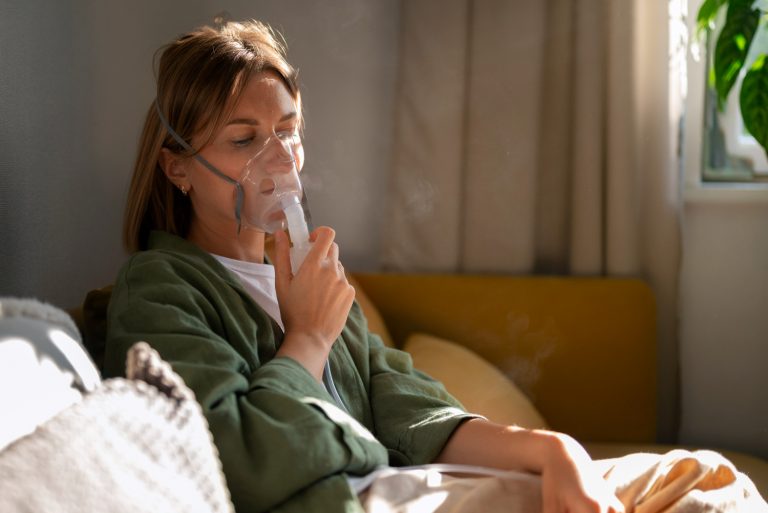or people with bronchial asthma, the seasonal rise in the incidence of influenza, acute respiratory viral infections and other infections affecting the respiratory tract is particularly dangerous. The natural reaction of the body to the invasion of pathogens is inflammation – it helps to cope with the infection faster. However, against the background of asthma, this inflammatory reaction can provoke attacks of suffocation. Therefore, it is important to take measures to avoid exacerbation throughout the cold season.
Bronchial asthma
Bronchial asthma is a chronic disease in which the patient has attacks of suffocation due to the impact of certain stimuli (triggers, irritants).
In the course of the disease there is a pre-attack period, the attack itself, inter-attack period, and in the long-term absence of attacks (from 12 months and more) speak about the onset of remission.
The less often a person is bothered by attacks of suffocation, the higher his chances of achieving long-term or complete remission, in which the need for medication disappears, there are no signs of inflammation in the respiratory tract, and lung function is fully restored. For this reason, it is essential to minimize the risks of seizures. One of the most important tasks aimed at preventing exacerbations of bronchial asthma is the prevention of acute respiratory infections that can trigger attacks, as well as reducing the activity of inflammation in the airways between attacks.

Which respiratory infections increase the risk of attacks
There are many triggers that provoke an asthma exacerbation. These include plant pollen, house dust, products of household mites and cockroaches, animal dander and hair, mold, household chemicals, perfumes, industrial pollution. Stress, food allergens, physical activity, certain medications, and cold air can also act as stimuli.
However, studies show that about 85% of cases of exacerbation of the disease in children and about 60% – in adults is associated with acute respiratory infections (ARI).
And this happens, including people whose irritants belong to a different category, for example, in patients who previously reacted with attacks only to pollen or dust.
In adults, some bacteria can act as triggers. First of all, we are talking about the so-called causative agents of respiratory atypical diseases chlamydia and mycoplasma, which, like viruses, multiply inside the cell.
How to prevent asthma exacerbation during “cold season”
To prevent asthma attacks, it’s important to eliminate risk factors in the home. Here are some guidelines for establishing a safe space:
1. Protect against allergens and irritants:
- Don’t keep animals in the house, especially those that shed (cats, dogs, etc.). If this is not possible, limit their access to bedrooms.
- Avoid smoking in the house and grounds, especially indoors.
- Do not use strong-smelling products (soaps, shampoos, lotions, incense).
2. Furnish the bedroom for the person with asthma:
- Remove rugs and plaids that can accumulate dust and mold spores.
- Remove unnecessary upholstered items (chairs, pillows) that accumulate dust.
- Do not allow pets on the bed or in the bedroom.
- Do not allow smoking or the use of scented substances in the bedroom.
- Use dust-proof covers on your mattress and pillows.
- Wash bedding regularly in hot water and dry in the sun.
3. Keeping the house clean:

Cleaning is best done when the person with asthma is not present.
- Sweeping the floor and vacuuming.
- Dusting and painting.
- Using aerosol insect repellents.
- Using chemical cleaning products.
- Cooking food with strong odors.
After cleaning, the room should be ventilated before the person with asthma returns. If this cannot be done, use a wet mask while cleaning.
4. Air in the home:
- Ventilate the room when the weather is hot and stuffy, or if there is too much smoke or odors in the house.
- If the house is heated with wood or kerosene, keep a window ajar to improve ventilation.
- Close windows if there is a high concentration of pollutants, dust or pollen outside.
5. Physical activity:
- Be careful with physical activity as it can trigger asthma symptoms. Consult your doctor about the need to use medication to prevent attacks when exercising.
6. Prevention for children:
- Do not smoke during pregnancy or in the presence of children.
- Do not keep animals in the house, especially those with hair.
- Use dust-proof covers on mattresses in children’s rooms.
Following these guidelines will help minimize the risk of asthma attacks and improve the quality of life for the person suffering from this condition.
How to control asthma
- Follow your doctor’s prescription, use inhalers and medications for prevention and exacerbations.
- Measure your exhalation rate with a picflow meter and monitor your symptoms so you can react in time.
- Minimize contact with allergens and pollutants such as pollen, animal hair and chemicals.
- Proper nutrition, regular exercise (in consultation with your doctor) and stress reduction will help control asthma.
- Develop a plan of action in case of an attack with your doctor, including using medications and seeking help.

- Discuss symptoms and changes in treatment with your doctor to adjust therapy.
- Research the disease and communicate with other patients to share experiences and tips.
These steps will help you effectively control your asthma and improve your quality of life.
Doctor’s appointments
See your doctor for checkups two or three times a year. See your doctor even if you feel well and have no breathing problems.
Tell your doctor about any adverse events related to your asthma medications.
- Your doctor may change your medicine or change the dose. The choice of anti-asthma medicines is huge;
- Ask questions. Your doctor is your partner in managing your asthma;
- Asthma may become milder or more severe over the years. Your doctor may need to change your medication treatment.





